 |
|||
|
Plate
tectonics are the cause of earthquakes and volcanoes.
|
|||
| PLATE TECTONICS ON EARTH | |||
| The Earth's rigid lithosphere, including the crust and the uppermost part of the mantle, is split into plates which move over the weak, plastic asthenosphere. The motions of these plates account for the major geological processes at work on Earth today, including mountain-building. Tectonics is a term derived from the Greek for "builder". The Earth's continuing plate tectonic activity makes it unique in the Solar System. | |||
| Plates and Boundaries | |||
| There are six major tectonic plates consisting of both continental and oceanic crust. The large Pacific plate is mainly ocean crust and several smaller plates are largely one or the other. Plate boundaries are marked by intense geological activity, including volcanoes, earthquakes and mountain-building. Plate boundary features include the mid-ocean ridges and continental rift valleys at divergent boundaries, and deep ocean trenches and high mountain ranges at convergent boundaries. The large Pacific plate is young and fast-moving, surrounded by "the ring of fire" along its coasts. | |||
 The major plates of the Earth's crust. |
|||
| Plate motion | |||
| New ocean crust is created at the mid-ocean ridges, where lava erupts from the aesthenosphere and solidifies, pushing apart the plates on either side in a process called seafloor spreading. At the edge of an ocean basin, dense oceanic crust may move under lighter continental crust to form an ocean trench in a process called subduction. Continental crust may be torn apart at a rift valley, where new oceanic crust may eventually be formed. Plates may also slide past each other horizontally along a transform fault such as the San Andreas Fault, California. | |||
| Plate motions are driven by deep convection currents in the mantle. A mantle hotspot where hot material is rising may lead to stretching of the lithosphere, fracturing and rifting. This usually causes a three-way split of a continent and a "triple junction" of three smaller plates. Where cool material is sinking, the lithosphere may be dragged down, creating a subduction zone with the lithosphere re-absorbed up to 700 kilometres into the mantle. | |||
|
|
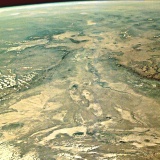 The floor of the Rift Valley has dropped relative to the Ethiopian Highlands on either side. |
||
| The oldest oceanic crust is 200 million years old, in contrast to continental rocks which are commonly older, indicating a rapid turnover of oceanic crust and relatively stable continental blocks. This is borne out by measurements of the speed of movement of individual plates - the oceanic Pacific and Nazca plates are spreading at 17 centimetres per year, whereas the Eurasian and North American plates, largely continental, are spreading at 2 centimetres per year. | |||
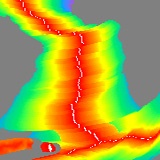 A map of the age of the rocks of the seafloor. |
|||
| Historical movements of the tectonic plates may be inferred from the paleomagnetic signature left in volcanic rocks. This information may be used to reconstruct the positions of the plates up to 600 million years ago. Plate motion has taken continents from the equator to the poles and back, dramatically affecting ocean circulation and climate. | |||
| Mountain Building | |||
| At convergent plate boundaries, mountain-building occurs due to a number of mechanisms. Sinking crust may melt in the asthenosphere, rising up as hot material to form large igneous intrusions or build volcanoes. The over-riding block of crust may be thickened, with sedimentary material at its margins scraped off the descending oceanic slab and uplifted. The increased pressure and heating at subduction zones is the origin of metamorphic rocks - originally sedimentary or igneous rocks whose mineral structure has been altered. | |||
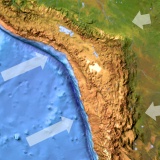 The Andes Mountains formed by compression uplift and volcanism behind a subduction zone. |
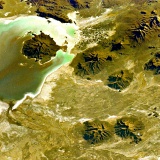 Swarms of volcanoes beneath the Andes Mountains. |
||
| Collisions of slabs of continental crust produce the greatest shortening and thickening and the highest mountains. With a similar rock density on both slabs, subduction does not occur. The continental rocks have nowhere to go but up, crumpling and uplifting for some distance away from the boundary. This is how the Alps in Europe and the Rocky Mountains of North America were formed. The collision of India with Asia happened so rapidly that the worlds highest mountain range, the Himalayas, was created, and a huge area, the Tibetan Plateau, was uplifted by crustal thickening. | |||
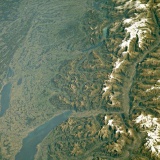 The Alps of Europe created by the impact of the African plate, on the Eurasian plate. |
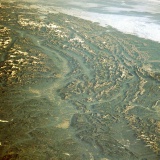 The Rocky Mountains, uplifted as fragments of continental crust under- rode the North American Plate. |
||
|
|
 The Himalayas rise above the floodplain of the Ganges (left corner), with the high, dry Tibetan Plateau behind (right corner). |
||
| Effects of Plate Motion | |||
| The circulation of water between the major ocean basins has been dramatically effected by the shifting positions of the continents due to tectonic plate motions. At times, heat has been carried by the oceans from equator to pole with little restriction, leading to a warm climate. Currently, ocean heat transport to the poles is restricted by the northern continents and the strong southern Circumpolar Current, leading to year-round polar icecaps which expand every 150,000 years in a cycle of ice ages. | |||
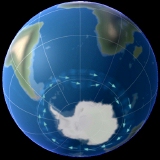 The Circumpolar Current blocks ocean heat flow across the Southern Ocean, leading to a thick continental icecap in Antarctica. |
|||
| Major geological events such as the eruption of extensive lava plateaux and the uplift and exposure of large areas of crust have also altered the chemical composition of the atmosphere. The Indian monsoon weather system has arisen due to the presence of the large Tibetan Plateau uplift. All these climate changes have effected the evolution and distribution of life on Earth. | |||
|
|
|||

